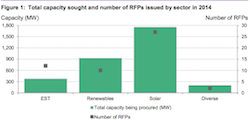A new paper released from research firm Bloomberg New Energy Finance has found that North American utility companies focused on two sectors in 2014: advanced energy storage and solar. Analysts tracked 52 clean energy requests for proposals (RFPs) released in 2014, and found that solar dominated the field with more than 27 RFPs, and that Western states sought the most capacity. The white paper details several trends including:
- Solar dominated the market, both in capacity (1.8GW) and quantity (27 RFPs). There was also a significant amount of interest (at least 12 RFPs) in energy smart technologies, particularly energy storage.
- Western states represented the biggest region for RFPs, with 1GW being requested. The Southeast was the second-largest region in terms of capacity requested, almost all of it solar.
- Wisconsin-based Alliant made the biggest splash in capacity sought with a single RFP.
- Collectively, the US armed forces issued seven RFPs.
“The data reveals particularly strong interest in energy storage,” said Will Nelson, head of analysis for Bloomberg New Energy Finance in North America. “Interestingly, most storage RFPs are looking for a relatively small amount of capacity, evidence that these may be initial experimental forays into a rapidly changing sector.”
Nelson said RFPs are a leading indicator for trends in the utility industry because they are solicitations issued by companies to potential vendors. The issuers of RFPs specify the products or services they are seeking. In response, bidders submit proposals, competing against each other on the basis of pricing, capabilities, and other factors. In the world of clean energy, RFPs could involve procurement for renewable electricity-generating capacity or for technologies to make the grid more flexible or resilient.
“For project sponsors and equipment vendors, RFPs are the lifeblood of their business development efforts,” added Mark Taylor, product manager for Bloomberg New Energy Finance. “They also give an early but concrete glimpse into which sectors are catching the eye of the market, and about the strategic direction of utilities and other energy-consuming organizations.”


